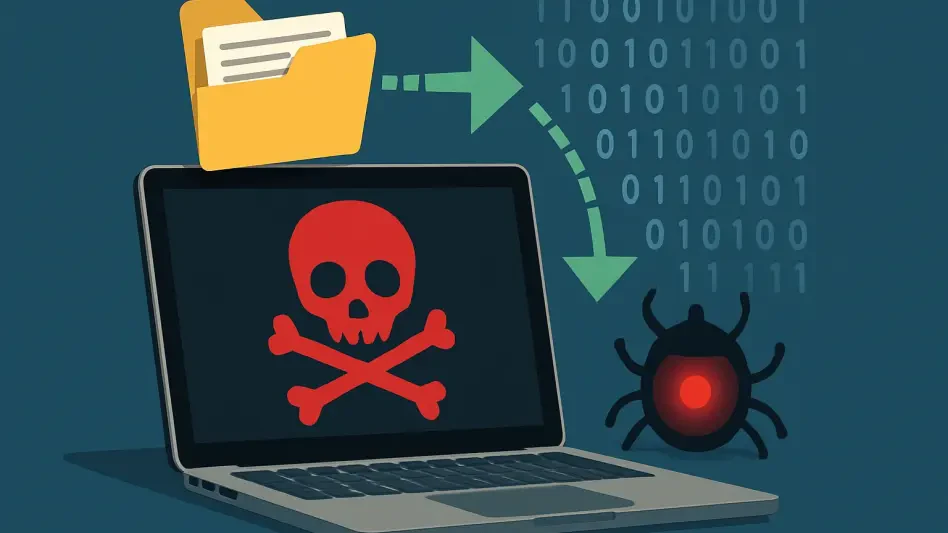In the ever-evolving landscape of cybersecurity threats, a chilling new player has surfaced for macOS users: a malware known as Mac.c. This dangerous infostealer, derived from the notorious Atomic macOS Stealer (AMOS), has captured attention on the dark web for its ability to pilfer sensitive data at an unprecedented pace. Marketed as a malware-as-a-service (MaaS) by a threat actor identified as “mentalpositive,” Mac.c employs sophisticated techniques to target everything from passwords to cryptocurrency wallet information. Its rapid execution and minimal digital footprint pose a significant challenge to traditional security measures, raising urgent questions about how such a threat can operate so efficiently under the radar. With deceptive installers and a focus on high-value digital assets, this malware represents a growing risk for macOS environments. Exploring the mechanisms behind its speed, the tactics it uses to deceive users, and the broader implications of its presence in the cybercrime market reveals a troubling trend in targeted attacks on Apple systems.
Unpacking the Speed of Data Theft
Mac.c distinguishes itself in the malware arena through its relentless focus on speed and efficiency during data theft operations. By leveraging built-in macOS utilities such as AppleScript and system APIs, it integrates seamlessly with legitimate processes, evading detection by many standard security tools. This approach drastically reduces its detectable footprint, allowing the malware to operate covertly while extracting sensitive information like iCloud Keychain credentials and browser-stored passwords. The optimized binary size further enhances its agility, ensuring that data exfiltration happens in mere moments. Unlike more cumbersome threats that rely on external libraries or heavy codebases, Mac.c’s streamlined design prioritizes quick execution, making it a formidable foe for endpoint detection and response systems that struggle to identify such subtle intrusions.
Beyond its technical efficiency, the malware’s architecture is tailored to prioritize high-impact data for rapid theft. Once embedded in a system, Mac.c swiftly targets critical assets, including login credentials and system metadata, without unnecessary delays caused by extraneous functions. Its ability to harvest information with minimal interaction ensures that victims remain unaware of the breach until significant damage has been done. This focus on speed is not just a feature but a core strategy, enabling cybercriminals to maximize their gains in the shortest possible window. The implications are stark for macOS users, as traditional antivirus solutions often lag behind in catching threats that exploit native tools. As a result, the need for advanced, behavior-based detection mechanisms becomes increasingly apparent to counter such fast-acting malware in real-time environments.
The Art of Deception in Deployment
A key factor in Mac.c’s rapid data theft lies in its cunning methods of infiltration, often catching users off guard with deceptive packaging. Disguised as legitimate software installers, such as cracks for popular Adobe products or even fictitious games with enticing names, the malware lures unsuspecting individuals into granting it access. Once installed, it employs sophisticated tricks like mimicking authentic system prompts to extract passwords and other sensitive data in plaintext. This psychological manipulation exploits user trust in familiar interfaces, ensuring that the malware gains entry swiftly and begins its theft process without raising immediate suspicion. Such tactics highlight the growing sophistication of phishing strategies tailored specifically for macOS ecosystems.
Moreover, Mac.c hones in on high-value targets to amplify the speed and profitability of its attacks. Cryptocurrency wallet data from extensions and applications like MetaMask, Binance, and Ledger Live are prime objectives, swiftly exfiltrated to attacker-controlled servers. This focus on digital assets, which can be converted or transferred quickly, underscores the malware’s intent to capitalize on financial gains in minimal time. The seamless integration of fake dialogs and trojanized installers ensures that users inadvertently facilitate their own compromise, often before realizing the breach. For macOS users managing digital currencies or sensitive information, this serves as a critical reminder to scrutinize every download and interaction with system prompts, as the cost of a momentary lapse can be devastating in the face of such targeted and efficient threats.
Evasion Through Innovation and Transparency
The development process behind Mac.c offers a unique glimpse into how modern malware achieves both speed and stealth through innovative evasion techniques. Unlike many threats crafted in secrecy, the creator, known as mentalpositive, has adopted a remarkably transparent approach by sharing code updates and feature enhancements on dark web forums. This openness not only builds credibility among potential buyers in the MaaS community but also allows for rapid iteration of features like remote file grabbers and dynamic build generation. These advancements ensure that each instance of Mac.c is uniquely obfuscated, effectively dodging Apple’s XProtect antivirus signatures and maintaining its ability to steal data without interruption from conventional security barriers.
Additionally, the use of dynamic builds and minimal reliance on external dependencies enhances Mac.c’s capacity to evade detection while sustaining its high-speed operations. By continuously evolving through community feedback and publicly documented updates, the malware stays ahead of static signature-based defenses that struggle to keep pace with such adaptability. Features like expanded browser compatibility for password theft and specialized modules for phishing cryptocurrency wallet seed phrases are integrated with precision, ensuring that data theft remains both fast and focused. This blend of technical ingenuity and strategic transparency in the underground market reveals a troubling evolution in malware creation, where collaboration among threat actors accelerates the refinement of tools designed to exploit macOS vulnerabilities with alarming efficiency.
Market Strategy and Rising Threat Level
Mac.c’s competitive edge in the cybercrime market is further sharpened by its aggressive pricing model, making it accessible to a wider array of threat actors. At a subscription cost of $1,500 per month—significantly lower than AMOS’s $3,000 monthly fee—it democratizes access to sophisticated malware capabilities. Optional add-ons, such as a $1,000 one-time fee for a Trezor phishing module, cater to specific criminal interests while keeping costs manageable. This affordability fuels its proliferation through phishing campaigns and malvertising, enabling even less-resourced attackers to deploy a tool optimized for speed. Despite offering fewer supported wallets and extensions compared to established competitors, Mac.c’s focus on rapid data theft ensures its appeal in a niche but growing market of macOS-targeted threats.
The growing popularity of Mac.c, driven by its cost-effectiveness and efficient design, signals an escalating risk for macOS users, particularly those handling cryptocurrency or sensitive data. Live samples detected in filenames like “Installer.dmg” confirm its active distribution, often catching victims through deceptive downloads. This accessibility, combined with a streamlined focus on high-value data exfiltration, positions Mac.c as a catalyst for broader malware trends in the MaaS ecosystem. Security experts emphasize that signature-based detection falls short against such dynamically evolving threats, underscoring the urgent need for behavioral analytics in protective tools. As Mac.c gains traction among cybercriminals, the potential for widespread impact grows, demanding heightened vigilance and updated defenses to mitigate the dangers posed by this fast-acting infostealer.
Navigating the Future of macOS Security
Reflecting on the emergence of Mac.c, it becomes evident that this malware marks a pivotal moment in the landscape of macOS-targeted threats. Its ability to steal data with remarkable speed through native tool exploitation and deceptive tactics has exposed critical gaps in traditional security frameworks. The transparent development approach and competitive pricing adopted by its creator have fueled its rapid adoption among cybercriminals, amplifying the scale of potential damage. This infostealer, though not as feature-rich as some predecessors, has carved a niche through efficiency and affordability, setting a precedent for future malware innovations.
Looking ahead, actionable steps emerge as essential to counter such evolving dangers. Enhancing security with behavior-based detection systems stands out as a priority to identify and block threats like Mac.c before significant harm occurs. Educating users about the risks of unsolicited downloads and the importance of verifying system prompts proves equally vital in preventing initial compromise. For the macOS community, adopting a proactive stance through updated tools and awareness initiatives offers the best path forward, ensuring resilience against the next wave of fast-moving, sophisticated malware poised to exploit digital vulnerabilities.








